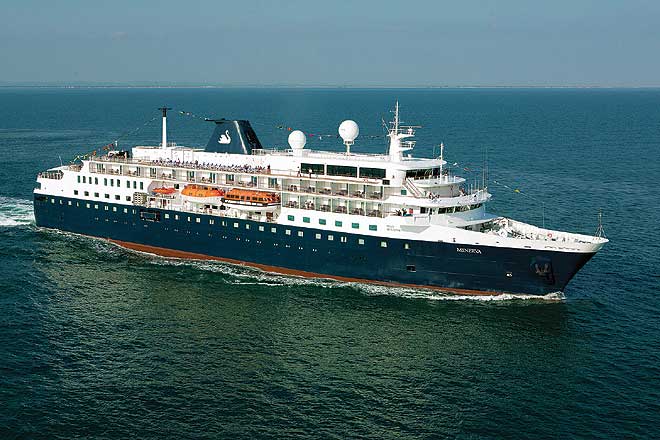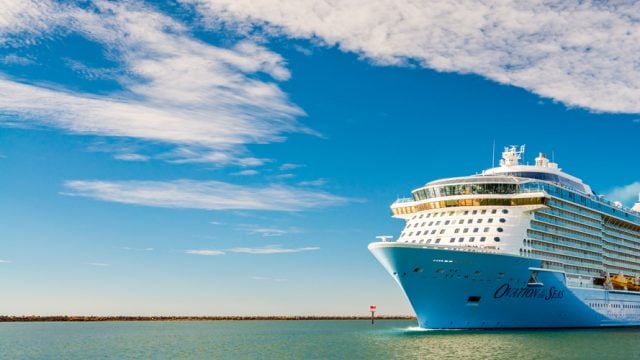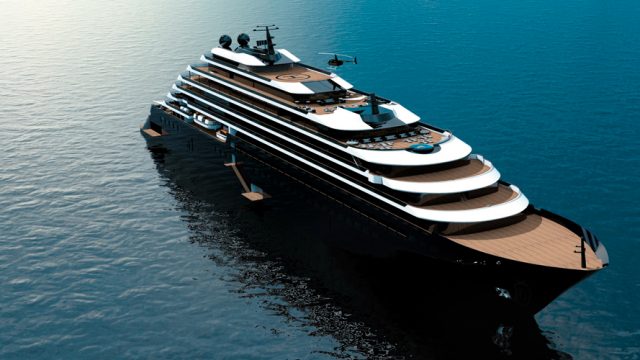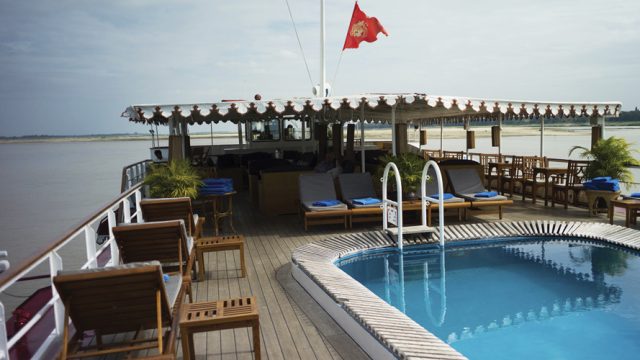Cruising, for me, is not so much about the places I visit en route. I don’t, as
My passion for ships and trains was born in me before I can remember. I think it was 1937, and I was only two, when my father, a Calcutta businessman, took his family on home leave. We travelled by the mail train to Bombay, where we boarded the P&O Liner The Viceroy of India, and sailed to Tilbury docks. I remember the voyage that ended my Indian childhood on the cargoliner The Chinese Prince. In February 1945, we sailed down the Hooghly from Calcutta. As the war had not yet ended, not even the captain knew where the ship would finally dock. All was peaceful until Gibraltar, where we were told we would have to join a convoy escorted by the Royal Navy Corvettes, the smallest warships, because German U-boats were still active. My mother was incensed because the padre had terrified us children by preaching a sermon warning us to “prepare to meet your maker.” But my strongest memory is of an old, slow, tramp steamer gradually falling behind the convoy. As I watched the gallant vessel fade away, I remember feeling desperately sad, imagining her being all on her own, a sitting target for the U-boats.There was great excitement in our convoy in the Irish channel when the Corvettes hoisted black pennants, indicating there was a German submarine nearby. Fortunately, we were not troubled by it and landed safely in Glasgow.

Aeroplanes, which I detest, have almost put liners out of business, but there is one ship, Queen Mary the Second, launched in 2004, which provides a seasonal liner service across the Atlantic. Unlike modern cruise-ships which are rectangular and look like floating hotels, the QM2 is a beautiful streamlined ship, designed to cut through the Atlantic waves at high speed. I was scheduled to sail to New York as a lecturer on the QM2, but when I checked in at Southampton docks I was turned back because my passport, although valid, was old and didn’t have electronic writing on it. Apparently it was beyond the wit of the American immigration authorities to read ordinary writing. There was this magnificent ship towering over me, and there was I with just the rail journey home, round the south coast, as compensation.
My three voyages on Minerva, however, have more than made up for that disappointment. Swan Hellenic, who run the Minerva, take great pride in being different. The line was founded in 1954 to provide cruises on a comparatively small ship for the intellectually inclined. Distinguished lecturers who really knew their subjects would give lectures on board about the destinations to be visited. Originally the cruises were limited to the ancient sites on the Mediterranean, but now Minerva sails from Norway to East Asia via India and Sri Lanka. I once had the thrill of giving a lecture from the bridge as we sailed up the Hooghly to Calcutta, negotiating the notoriously treacherous river with its constantly shifting sand banks. Minerva’s voyage is divided into fortnight-long sectors, each one a separate cruise. The Minerva was once replaced by a larger ship, but Swan Hellenic’s faithful passengers didn’t like that. One of them, happily back on Minerva, said to me disparagingly, “…it had become like a booze cruise.”
Although I am a journalist and not an academic like most others who lecture on Minerva are, I have always sailed on her as a lecturer. This has many advantages, the most obvious one being that you travel free. On my past cruises, the lecturers’ drinks were free and we were also encouraged to order drinks for other passengers to sustain the bonhomie of the cruise. This time round I had to pay half-price but I still encouraged others to join me. Another advantage I find as a lecturer is the ease with which I make friends, first with my fellow lecturers and then with passengers who are interested in knowing more about India, the subject of all my lectures.
On any long sea voyage, the ship becomes a closed society, an institution you might call it, and my long years in boarding schools taught me to enjoy institutional life and the friendships that come with it. On a voyage to India during the British Raj, a handsome steward thought he had established a firm friendship with a young woman, the daughter of the Governor of a Province. The morning after the friendship developed, he naturally greeted her warmly, but she replied frostily, “Young man, don’t think that because a woman sleeps with a man he has been introduced to her.”
The Minerva tends to attract comparatively elderly passengers from a British middle class background. This too makes friendships easier, but on one cruise my partner Gillian Wright said to me, “If anyone else comes up to you to talk about Public Schools National Service and Oxford or Cambridge, I am getting off the ship.”
Just as I’d expected on this cruise to Singapore, I once again thoroughly enjoyed life at sea—the bonhomie and friendships, the four excellent meals each day, the chance to read in Minerva’s capacious well-stocked library, and the lectures of my colleagues. I kept promising to cut out the afternoon tea, but I just couldn’t resist the traditional British scones and cream. Then, of course, there was the sea itself, its vastness, its many different moods, and the sense of being at one with the universe as I watched the dawn sun gradually rising over the distant horizon or walked round the promenade deck under the night skies. I have heard of veteran cruisers who enjoy the ship so much they don’t bother to disembark when they reach one of the destinations. But I did get off the boat at the destinations we visited, and enjoyed them thoroughly.

For me, Yangon was the highlight of the cruise. We sailed all the way up the river to dock in the city centre, almost opposite the famous Strand Hotel, unlike the previous time when the Minerva had stopped at some non-descript dock outside the city. On the first night we were taken to the Shwedagon Pagoda, sometimes called the world’s most famous pagoda, which also claims to be the oldest one as well, about 2,600 years old. When we emerged from the lift onto the broad pavement which surrounds the dome, we saw that it was covered with a network of scaffolding. But that didn’t diminish the impact of this extraordinary place of worship, nor did it appear to diminish the devotion of those, young and old, praying in the shrines surrounding the dome.
Another highlight of Yangon was a journey round the city on the circular railway in the company of my fellow Minerva passengers, who were railway enthusiasts as well. The train travelled slowly, rocking precariously on tracks in need of maintenance. We passed through new Yangon with its tower blocks, and we stopped at stations which appeared to be in the middle of the countryside. These were the traditional Burmese villages which survive inside Yangon. When we came to a sizeable market, the train was invaded by men and women with huge sacks of vegetables. The travelling ticket examiner swooped on them, insisting they pay for their baggage. I noticed that the payments went straight into his pocket. No ticket was issued. Although the Burmese economy is said to have been wrecked by years of military rule, we didn’t see any overt signs of poverty on our journey.

In Malaysia, the highlight was lunch in the Eastern & Oriental Hotel in Penang, one of the three renowned Grand Hotels of the East founded by the four Sarkies brothers, Americans who came originally from Persia. The other hotels are Yangon’s Strand, where I also had lunch, and Singapore’s Raffles. The writer Somerset Maugham is one of a long list of famous people who have stayed in the hotel. It’s easy to imagine him sitting on the hotel’s long sea-front as the sun set, drinking a pink gin. The lunch was the most magnificent buffet I have ever seen. There was crab soup along with baked oysters, baked salmon, mussels , Japanese octopus and Japanese style prawns. And that was just the beginning. I chose the crispy roast duck, although my British origins tempted me to go for the traditional roast lamb and roast potatoes.

We sailed from Penang through the straits of Malacca, with the coastline in sight, until we came to the town of Malacca. Once there, we climbed up a steep hill to the ruined church of St. Paul. Inside we were shown what looked like just another hole in the ground but this was apparently the tomb where the body of St. Francis Xavier, who had died in China, lay for nine months before being taken to his final resting place in Goa. Known as the Apostle of the East, St. Francis had played a leading role in converting Indians to Christianity. Malacca was a major Dutch trading port in the 19th century, a rival to Penang which the British had established. Unfortunately the charming buildings of old Malacca which still form the centre of the town are dwarfed by the ugly high-rise buildings surrounding it.
When we finally docked in Singapore, I opted to revisit the Botanical Gardens with their magnificent orchids. In the evening, to complete the trio of the Sarkies’ Grand Hotels, a group of us went to Raffles bar. We tried to forget that this was the end of the cruise, but I must say our spirits came crashing down when the bill was presented.
The one disappointment about cruises is that all too often they end with a journey by air. That was my fate too. My flight from Singapore to Delhi was as expected an anti-climax and as drab and dreary as flights inevitably are. But at least I still had the memory of two wonderful weeks at sea.
The information
Swan Hellenic (www.swanhellenic.com) organises cruises with a difference, with guest speakers and entertainers on board, in Scandinavia, the Levant, south and southeast Asia among others. Typically the cruises run for 15 days, and start from approximately £1,799 per person depending on the trip. The Burma and Beyond cruise departs from Colombo, and visits Yangon, Langkawi, Penang, Malacca, and Singapore. Check the website for sailing dates.
Minerva
Swan Hellinic cruises
Leave a Reply
You must be logged in to post a comment.





